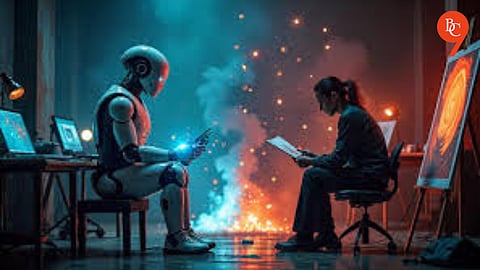

But history offers a reassuring answer: No. In fact, it's always adapted—and often thrived.
GenAI isn’t the end of human creativity. It’s the next version of the same old story: evolution through disruption.
A Brief History of Panic (and Progress)
Every time a new technology has emerged, there’s been fear that it would replace creativity:
Photography was once thought to be the death of painting.
Digital music production supposedly ended musical “authenticity.”
Word processors were accused of eroding the craft of writing.
Yet in every case, artists didn’t disappear. They just evolved. Painters experimented with abstraction, musicians embraced electronic sounds, and writers began to explore storytelling in entirely new forms.
The lesson? Creative people don’t fear tools—they wield them.
What GenAI Actually Offers Creatives
Rather than eliminating originality, Generative AI amplifies access, speeds up ideation, and frees up time from repetitive tasks. Here’s how:
Designers can now explore hundreds of layout iterations in minutes.
Writers can brainstorm, outline, or generate drafts to beat writer’s block.
Filmmakers can pre-visualize scenes with text-to-video tools.
Marketers and content creators can scale campaigns without burning out.
But the most important element—taste, intent, emotion, and context—still comes from human intuition.
GenAI can draft, remix, and assist. But it doesn’t feel. It doesn’t dream. That’s still your job.
Creativity in the Age of Collaboration
Think of GenAI not as competition, but as a collaborative partner—a digital muse. You still set the direction, mood, and message. AI can help sketch, but you choose the lines worth keeping.
In many ways, this moment is forcing artists, writers, and thinkers to ask deeper questions:
What makes an idea truly original?
What does “voice” mean when anyone can generate one?
How can human values guide machine capabilities?
Creativity Is a Survival Trait
What history—and psychology—shows us is this: creativity isn’t optional for humans. It’s hardwired. From cave paintings to TikToks, we’re driven to make, express, imagine, and connect.
Generative AI may automate certain outputs, but it can’t replace human experience—our memories, heartbreaks, humour, contradictions, and culture. These are the raw materials that machines don’t have access to.
So, if you’re a writer, designer, student, or storyteller wondering where you fit in this GenAI world, here’s the truth: you’re still essential. But you might need to evolve your toolkit.
Creativity has never stood still—and it never will. GenAI isn’t a threat; it’s a turning point. And like every great story arc, the hero (you) must learn how to grow with the world around them.
